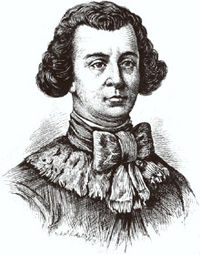- Thomas Dongan, 2nd Earl of Limerick
-
Thomas Donegan, 2nd Earl of Limerick (1634 – 14 December 1715) was a member of Irish Parliament, Royalist military officer during the English Civil War, and governor of the Province of New York. He is noted for having called the first representative legislature in New York, and for granting the province's Charter of Liberties.
He was born in 1634 in Castletown Kildrought (now Celbridge), County Kildare in the Kingdom of Ireland. He was the youngest son of Sir John Dongan, Baronet, Member of the Irish Parliament. As Catholics, his family faced persecution after the overthrow of Charles I and fled to France. While in France, he served in an Irish regiment with Turenne. He continued to stay in France after the Restoration and achieved the rank of colonel in 1674.
After the Treaty of Nijmegen ended the French-Dutch War in 1678, Dongan returned to England in obedience to the order that recalled all English subjects fighting in service to France. James, Duke of York, who had served as a fellow officer of Dongan's in French army, arranged to have him granted a pension and high-ranking commission in the army and designated for service in Flanders. That same year, he was appointed Lieutenant-Governor of Tangiers. In 1682, James, who had become the Lord Proprietor of the Province of New York after it was acquired from the Dutch, appointed Dongan as provincial governor (1684–1688) and granted him an estate on Staten Island. The stone farmhouse was called The Christopher House. The estate eventually became the town of Castleton; later, another section of the island was named Dongan Hills in honour of Dongan. He was replaced as Governor by Francis Nicholson.
At the time of his appointment, the province was bankrupt and in a state of rebellion caused by the mismanagement of the previous governor. Dongan was able to restore order and stability through tactful means. On 14 October 1683, he convened the first-ever representative assembly in New York history, which convened at Fort James.
Dongan was to grant land grants to establish several towns throughout New York State including the eastern Long Island communities of East Hampton and Southampton. The land grants were called the Dongan Patents. The patents set up Town Trustees as the governing bodies with a mission of managing common land for common good. The Dongan Patents still hold force of law and have been upheld by the US Supreme Court with the Trustees—rather than town boards, city councils or even the State Legislature—still managing much of the common land in the state.[dubious ]
In 1698, his brother William, Earl of Limerick, died with issue. Because of his service to the Crown as a military officer and as provincial governor, he was granted his brother's title and a portion of his brother's forfeited estates by a special Act of Parliament for his relief.
See also
- Donegan (disambiguation)
- Donegan (surname)
References
- Driscoll, J.T. (1909). Thomas Dongan. In The Catholic Encyclopedia. New York: Robert Appleton Company. Retrieved 1 November 2008 from New Advent: [1]
External links
- Catholic Encyclopedia article on Thomas Dongan
- Thomas Dongan and the East Hampton Patent
Peerage of Ireland Preceded by
William DonganEarl of Limerick Extinct Categories:- Irish people
- Colonial governors of New York
- Earls in the Peerage of Ireland
- American people of Irish descent
- People from County Kildare
- 1634 births
- 1715 deaths
- Kingdom of Ireland emigrants to the Thirteen Colonies
Wikimedia Foundation. 2010.

